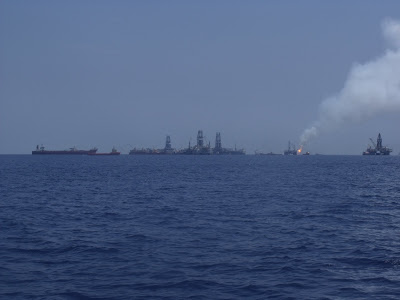Not that I'm necessarily skating along the jagged brink of disaster by posting about my life down here in Louisiana, since I'm sharing no data or observations on our data. Though I am slowly going through some of the laws concerning this. BP, which is ultimately paying for the remediation and the science work going into the natural resources damage assessment (NRDA), is doing its best to close down all public access to any relevant information.
I find this odious. I did make a brief statement on it in an earlier post, and I'm not trying to lose my job or cause anyone else to lose theirs.
However, there are laws behind this NRDA, and I'm going about reading them, to see if it's specified how much access the general public has to scientific information, both during and after the collection process. Right now we, as well as government groups like NOAA, are guarding everything pretty carefully. Unaffiliated scientists especially would love access to all of this information. (The general public might be mildlly interested, but also not as able to interpret things. The hard data's for the geeks.)
So there's a general aroma of secrecy about our work, even though we're simply monitoring the environment. And even within the operation there are sharp edges, pieces out of place and the occasional slash and bleed.
That metaphor isn't meant to imply actual injury--though those have occurred, in many phases of this remediation work--but rather, discord and interference among the different parties involved. I'm on board the Ridley again, as we steam back out toward the wellhead, having spent nearly the last full week on shore, and having spent four days before that exiled to the outer margins of the Deepwater site.
Last week, when BP opened up the damaged riser in order to fit it with a new cap, we were pushed off-site and prohibited from doing any monitoring. The chain of events was as childish and stupid as it was exasperating: local boat contractors refused to communicate with the Ridley's Filipino crew, claiming we were driving erratically and refusing to respond to radio hails.
Lies, all of it. This crew, from the captain down to the steward, is one of the best and most professional I've ever worked with. Only NOAA boats might be better, among those I've worked on, and that's only because they're more plush. (I hear Fugro ships are kind of like cruise vessels for the science crew, but I wouldn't know.) What I can say, during the time I've spent on bridge and in every interaction I've had with these guys, is that they keep a clean ship and they're very serious about their work.
But some locals didn't like their accent, didn't like how they're all business on the radio, and didn't like that this ship is flagged out of the Marshall Islands (known, along with Panama and Liberia, for its lax-to-nonexistent maritime regulation--making those three nations' flags popular to fly in the merchant marine). The local boys ganged up on the foreigner. To what extent BP was not unhappy with this, due to the opening of the wellhead, I can't say but I can say how frustrated I am.
We're here to look at the spread of oil. I realize that our work, compared to stopping the flow of oil, is right now unimportant. Shoot all the sonar we want, we have no influence on the leak, or on any decisions concerning it. Our work is exclusively for down the road.
And it's that down the road aspect which outrages me. There are possibly six or more vessels at various times doing testing and taking samples in the vicinity of the wellhead. The Ridley Thomas is one of four ships, along with NOAA's Thomas Jefferson, which does acoustics, and for most of last week, we were the only one on site. It's the acoustics, as imperfect as this application is, which can provide a large-scale view of the subsurface oil. The more our results are correlated to chemical tests, the bolder we can become with our interpretation. Gathering as much data as we can about the spread of oil below the ocean's surface is the best contribution we can make now to future science. Our best opportunity to inspect and measure the seafloor gusher last week was summarily taken away from us. Our best chance to contribute to posterity's

knowledge of seafloor blowouts and current activity in general is gone.
That frustrates me.
So now BP's finally given permission, and we're going back to the wellhead, likely with the good ole boys no more kindly disposed to our crew than before, to take a few days' data before heading back to Fourchon in 84 hours.
Yes, No Complaints Club. I'm not going to stop doing my work--rather the opposite!--but I don't like being jerked around.
So here I am, on a boat being hit with a steady stream of jabs and uppercuts in the form of 4-6' waves. A new tropical wave, Invest 97 (still don't understand that Invest thing), is lurking behind Puerto Rico and bidding to make straight for us. Should be an intriguing couple of days.
I won't post a photograph, but today's snack from the kitchen is a little alarming. Donuts, which are fine--topped with what seems like Tartar sauce (smells like it too), and grated cheese.
Great time to start slimming down again, huh? To get rid of the face pudge...and the rest of the pudge, for that matter. I'm starting to look a little more like the "after" in this before-and-after picture series...and yes, it's the same guy.
Before: thin Val.
After: fat Val. Wonder
when he's due?...



 Gator #2
Gator #2 Gator #3 (heading toward me at the time)
Gator #3 (heading toward me at the time) Work at the fantail. A busy place, with the A-frame still being assembled!
Work at the fantail. A busy place, with the A-frame still being assembled! Not sure I'd want to be wedged between a 130-foot boat and the dock.
Not sure I'd want to be wedged between a 130-foot boat and the dock. Ye olde A-frame, which will tow the fish.
Ye olde A-frame, which will tow the fish. The towfish, with most of the equipment still to be added.
The towfish, with most of the equipment still to be added. Just a spot of deckwork...
Just a spot of deckwork... Ryan, one of the guys running the spectrometer (a tool which identifies chemicals in the water).
Ryan, one of the guys running the spectrometer (a tool which identifies chemicals in the water). The rear deck, from the superstructure and looking aft. (The big white container on the right is the control van.)
The rear deck, from the superstructure and looking aft. (The big white container on the right is the control van.) Sunset over the Emily Bordelon.
Sunset over the Emily Bordelon.
















































